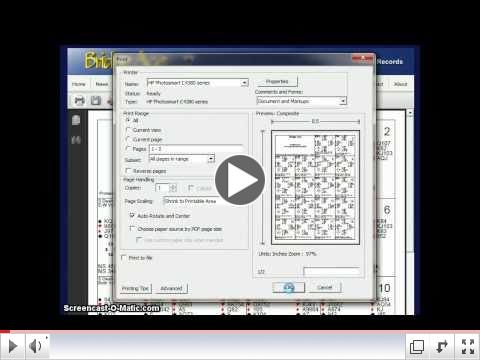 | |
The trophy for the world championship is named after the place where it was first played. What is the name of the trophy, which is still played for today?
Scroll down to find out. |
| Forward to a Friend |  | |
If you enjoy our Deal of the Week newsletter, why not forward it to a friend?
|
| Sign Up for Our Mailing List | |
If this newsletter was forwarded to you, sign up to be added to our mailing list.

|
The Daily Deal

Each day we "seed" one lesson deal somewhere into our otherwise randomly dealt set of boards. The board number is different each day. You never know which board it is. The daily deal is a free mini-lesson. You can take home a handout of the daily deal every day. We hope you find it educational as well as entertaining. To see past Daily Deals, click here. |
|
Replay At Home
 | |
Replay Boards at Home Video |
You can replay the boards you've played at the club - in the comfort of your own home.
Replay the exact same hands with any of several commercial bridge programs such as GIB or Bridge Baron if you own one. If you have not purchased one, we have a free program for you to download.
Watch the video above or click here for further instructions. |
|
Print at Home
 | |
Print Hand Records Video |
|
Download and print hand records from any game played at Bridge Ace.
Watch the video above or click here for further instructions. |
|
Free Bridge Lessons

Rich answers your questions every Tuesday prior to the game. |
Thursdays, we have a vugraph presentation. Rich reviews interesting deals of the past week. Each board in question is projected onto our large video screen for all to see as we discuss it.
We also have many other free bridge lessons online at our website which you can find here. |
|

The BOLS Bridge Tips competition started in 1974, and took place on and off for more than twenty years. During that time, virtually all the world's greatest bridge players and writers contributed their ideas to the series.
Not sure what to lead? Can't decide the right bid? Want to make more contracts? Here are pointers from the all-time greatest names in bridge: Belladonna, Chagas, Flint, Garozzo, Goren, Hamman, Reese, Rodwell, Schenken, Wolff, Zia ... and many more.
They're all represented. Their advice is here for players of all levels.
These tips are terrific. You can find them on our website here. |
|

Since St. Demetrios is rented out so often on Saturdays, we now hold Saturday games at Billy Rose's bar, Jester's. It is located at:
801 W. Cypress Creek Road
Fort Lauderdale, FL 33334 |
|
Trivia Answer:
The Bermuda Bowl
The first official World Championship, between the USA, Europe and Great Britain, was held in 1950 in Hamilton, Bermuda. The USA was victorious. |
|
|
|
Continuing our series of famous bridge deals ...
The glory days of bridge in the media are long gone. In the thirties, the charismatic Ely Culbertson managed to get the world interested in bridge. His legendary matches were newsworthy, reaching the front page daily for weeks on end.
World War II marked the end of the bridge frenzy. Later, newspapers, radio and television hardly paid any attention to the card game.
Only once since the thirties was bridge front page news. That was in 1965, during the world championships at Buenos Aires ...
 | |
Terence Reese, left and Boris Schapiro, far right in Buenos Aires |
This is how it was reported in the June 4, 1965 issue of Time magazine:
Five-Finger Exercise
For days there had been an enormous amount of mysterious scurrying about at Buenos Aires' Plaza Hotel. It was most unusual, for the Plaza was the scene of a particularly staid and cerebral gathering: the 13th World Bridge Championship, among whose participants were some of the game's most polished players. They are normally a reserved and polite group. But there was reason for their excitability, and last week it came out in a terse, oblique communique from the World Bridge Federation.
"Certain irregularities," said the officials, had been reported and investigated. "The captain of the British squad ... very sportingly conceded the matches to the United States and Argentina." In plain words, Britain's crack bridge team, which had been leading in a match with the U.S. for second place, conceded that match as well as the one it had won from the Argentines. The tournament ended with Italy's team the winner, the U.S. second, Argentina third, and Britain last.
In plainer words, the incredible fact was that the two leading members of Britain's team had been accused of systematically cheating. One was Terence Reese, 51, a saturnine, abrasive Oxford chap, inventor of an esoteric, seldom-used artificial bidding convention known as the "Little Major." He was also England's most brilliant writer on bridge (author of twelve books, columnist for the Observer and London's Evening News), and one of the two or three best players in the world. The other man was Boris Schapiro, 53, a gregarious ex-wholesale-butcher, now a London baccarat dealer, and a longtime (25 years) partner of Reese's.
Peculiar Position
It was U.S. Player B. Jay Becker who, on the third day of the tournament, first spotted "something highly improper." Playing against Reese and Schapiro, Becker noticed that his opponents were holding their cards in a peculiar fashion: both Britons kept varying the position of their fingers; sometimes only one finger showed at the back of the fan of cards, sometimes there were two, or three-bunched together or splayed. Later, Becker watched Reese and Schapiro play against other teams. At first, he could not believe his eyes; it was inconceivable that two such highly regarded professionals should be so stupid as to cheat at all, let alone risk their standing with such juvenile self-indulgence.
Becker confided in teammate and partner Dorothy Hayden. She watched the Englishmen too, and agreed with Becker. Still uncertain, they passed their suspicions on to New York Times Bridge Columnist Alan Truscott and to non-playing U.S. Team Captain John Gerber. All four observed Reese and Schapiro closely; all concurred.
The Code Late that night, Becker, Mrs. Hayden and Truscott met privately and went to work on the finger code itself. It was Mrs. Hayden who broke it. "Let's see," she said, "on that hand he held up one finger; his hand showed only one heart. Maybe this holds true for other hands." Checking the records of past hands against notes that they had made during the observations, the trio found the pattern. One finger meant a singleton heart. Two fingers together meant two hearts; two spread in a V shape meant five. Three fingers clenched meant three hearts; three fingers spread apart indicated six. Four fingers together meant four. A holding of seven hearts or more could be indicated simply in the bidding. Holding the cards in the right hand instead of the left indicated a heart void.
Could all this be of value to experts? Most agreed it could. Tournament players usually strive for contracts in the highpoint major suits-hearts and spades-or in no-trump. But hearts is the lowest-ranking of the three, the "danger suit." An opponent can shut out a heart bidder with a spade call at small risk. This, in turn, makes it much more costly for the heart bidder to reach his contract. If he knows his partners heart length, he reduces his risks.
Inventive Mind With the evidence in hand, John Gerber informed British Team Captain Ralph Swimer and British Bridge League Chairman Geoffrey Butler. The two watched Reese and Schapiro play 18 hands. At a hastily called meeting of the World Bridge Federation's appeals committee next day, officials directly accused Reese and Schapiro of cheating. Both denied the charges. That afternoon the federation called a meeting of the executive committee, including Honorary President General Alfred M. Gruenther, himself a first-rate player.
At one point, Italian Team Captain Carlo Alberto Perroux, a Federation Vice President, put in: "I am a criminal lawyer. I do not want 99% proof; I want 100%!" Bursting into tears, Britain's Swimer cried: "It's not 99% ! It's not 100% ! It's 110% ! I know they are guilty!" How, Swimer prudently refused to say. At least one other man had no doubts. Geoffrey Butler turned to Reese and said bluntly: "You have an inventive bridge mind. You invented the Little Major. Now you have invented the Little Heart!"
When it was all over, Schapiro himself would say only that "I am through playing cards." Reese, supremely cool about it all, merely shrugged: "Frankly, I'm not surprised all this happened. When you are on the top, all sorts if people drag you down." The two then headed back to London to await disciplinary action from the British Bridge League. If they are found guilty, they could be blackballed for life, and never be permitted to participate again in a world tournament. |
 New Interclub Match |
|
This Thursday, we will have another interclub match vs. Anaheim Bridge Club. The last time we played them was a year ago. |
 The Evidence Cited by Truscott |
|
The "Buenos Aires Affair" spawned two books: Alan Truscott's The Great Bridge Scandal and Terence Reese's Story of an Accusation.
Here is one of the deals Truscott cited as evidence of cheating:

On his second bid, Shapiro psyched two hearts, a rebid which should show at least four hearts. This is a strange bid with very high risk. In an attempt to muddy the waters for the opponents, he risked his partner supporting hearts at a high level and the possible ensuing disaster.
However, if Shapiro knew Reese held just two hearts, there was no danger of support, and the obstruction could only gain. Shapiro knew the opponents had nine hearts between them and, likely, game. If they were doubled, they could run to two spades or three diamonds.
To most experts, this would seem to be compelling evidence of cheating, but Reese answered this allegation in his book.
Since the vulnerability was favorable it was reasonable for East to attempt this maneuver, Reese claimed, "As to the alleged risk, if I, as West had just one spade but five hearts, I too could have would certainly be alive to the possibility that partner's heart bid may not be genuine."
Reese also makes a point that if he knew his partner was short in hearts he too could have bid hearts to try and fool the opponents.
The British Bridge League eventually found Reese and Schapiro innocent of cheating; however, the World Bridge Federation found them guilty and banned them from W.B.F. events for three years. |
 Newsletter Archive |
|
We send out the Deal of the Week newsletter every week. You can view many of our past newsletters here. |
|
|
|
|